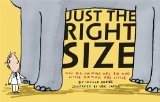Why Big Animals Are Big and Little Animals Are Little
by Nicola Davies
Illustrated by Neal Layton
Candlewick Press, 2009. 61 pages.
Starred Review
I think this book is so cool! It explains the math and geometry behind the sizes of living creatures in a way that is clear, easy to understand, and completely memorable.
Here’s the text on the opening page of the book:
“In comics and movies, superheroes zoom across the sky, run up wall, lift things as big as buses, and use their powers to fight giant monsters!
“It’s all very exciting, but it’s a complete load of nonsense. Real humans can’t fly, hang from the ceiling, or even lift things much bigger than themselves . . . and real giant animals couldn’t exist, since they wouldn’t be able to walk or breathe.
“In fact, there are very strict rules that control what bodies can and can’t do. These rules keep creatures from getting too big, and because of them the real superheroes are usually small — a lot smaller than humans.”
The basic rules she talks about come from the math of three-dimensional objects. If you double an object’s length, its cross-section will have an area four times bigger (since it’s squared), and its volume will be eight times bigger (since it’s cubed). The authors show this beautifully with plenty of illustrations.
Now I knew about this math, but I hadn’t thought about the repercussions in regard to living creatures.
They start by looking at flight. It’s easy for a fly to take off. But if you were to double the dimensions of a fly, suddenly its wings would be four times bigger. That’s a problem, because its volume is 8 times more, so it weighs eight times more than before, so the wings aren’t going to be big enough to get it airborne.
“This is why heavier insects, like dragonflies, need very big wings to get them off the ground, and birds need huge chest muscles and large, feather-covered wings.
“But wings and muscles can’t keep up with heavier and heavier bodies. That’s why really big birds like ostriches and emus can’t fly and walk instead, and why the only way humans can fly is with the help of engines.”
Next they look at insects that can walk on water and animals that can walk on the ceiling. This has to do with surface area related to volume. Again, if the surface area gets bigger, the volume gets bigger much faster.
This is also why we can’t lift buses. Our muscle strength depends on the cross-section size of our muscles, but weight depends on volume. A rhinoceros beetle can carry 850 times its own weight on its back, but humans sure can’t do that.
I love the author’s little story that illustrates why we can’t have mega-giants and giant spiders:
“Once upon a time there was a giant who was just like a normal human, only ten times bigger all over: ten times taller, wider, and deeper, making him one thousand times heavier. The giant took his first giant step, and with a giant crashing sound, both his legs snapped. The end. (And exactly the same thing happened to the giant’s best friend, the monster spider!)”
The illustrations accompanying this story are especially fun!
And so it goes. The book goes on to look at how you need room for enough internal organs to take care of the business of life, especially surface area in the lungs.
And there are more implications of size: Being able to stay warm, being able to digest things, being able to hide from predators, and so many more things.
The only down side to reading this? This book may dampen my ability to write fantasy stories about flying unicorns or dragons. But those are fantasy anyway, right?
With its clear explanations and fun cartoon illustrations, this book will make you look at the world with new eyes. A wonderful book for budding scientists, but also for anyone interested in the world around them — like me!
Find this review on Sonderbooks at: www.sonderbooks.com/Childrens_Nonfiction/just_the_right_size.html
Disclosure: I am an Amazon Affiliate, and will earn a small percentage if you order a book on Amazon after clicking through from my site.
Source: This review is based on a library book from the Fairfax County Public Library.
